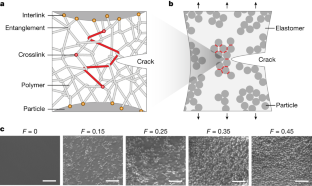2023-12-14 ハーバード大学
◆このアプローチは、タイヤなどのゴム製品の寿命を延ばすだけでなく、使用時に放出されるゴム粒子による環境汚染も減少させる可能性があります。通常のゴムの硬さ向上には成功してきましたが、疲労しきい値の向上は難しく、この研究で新しいアプローチが提案されました。
<関連情報>
- https://seas.harvard.edu/news/2023/12/rubber-doesnt-grow-cracks-when-stretched-many-times
- https://www.nature.com/articles/s41586-023-06782-2
- https://www.science.org/doi/10.1126/science.abg6320
ゴムの耐疲労性を増幅するマルチスケール応力分散 Multiscale stress deconcentration amplifies fatigue resistance of rubber
Jason Steck,Junsoo Kim,Yakov Kutsovsky & Zhigang Suo
Nature Published:13 December 2023
DOI:https://doi.org/10.1038/s41586-023-06782-2

Abstract
Rubbers reinforced with rigid particles are used in high-volume applications, including tyres, dampers, belts and hoses1. Many applications require high modulus to resist excessive deformation and high fatigue threshold to resist crack growth under cyclic load. The particles are known to greatly increase modulus but not fatigue threshold. For example, adding carbon particles to natural rubber increases its modulus by one to two orders of magnitude1,2,3, but its fatigue threshold, reinforced or not, has remained approximately 100 J m−2 for decades4,5,6,7. Here we amplify the fatigue threshold of particle-reinforced rubbers by multiscale stress deconcentration. We synthesize a rubber in which highly entangled long polymers strongly adhere with rigid particles. At a crack tip, stress deconcentrates across two length scales: first through polymers and then through particles. This rubber achieves a fatigue threshold of approximately 1,000 J m−2. Mounts and grippers made of this rubber bear high loads and resist crack growth over repeated operation. Multiscale stress deconcentration expands the space of materials properties, opening doors to curtailing polymer pollution and building high-performance soft machines.
絡み合いが架橋を大きく上回るポリマーの破壊、疲労、摩擦 Fracture, fatigue, and friction of polymers in which entanglements greatly outnumber cross-links
Junsoo Kim,Guogao Zhang,Meixuanzi Shi,and Zhigang Suo
Science Published:7 Oct 2021
DOI:https://doi.org/10.1126/science.abg6320

Longer and stronger; stiff but not brittle
Hydrogels are highly water-swollen, cross-linked polymers. Although they can be highly deformed, they tend to be weak, and methods to strengthen or toughen them tend to reduce stretchability. Two papers now report strategies to create tough but deformable hydrogels (see the Perspective by Bosnjak and Silberstein). Wang et al. introduced a toughening mechanism by storing releasable extra chain length in the stiff part of a double-network hydrogel. A high applied force triggered the opening of cycling strands that were only activated at high chain extension. Kim et al. synthesized acrylamide gels in which dense entanglements could be achieved by using unusually low amounts of water, cross-linker, and initiator during the synthesis. This approach improves the mechanical strength in solid form while also improving the wear resistance once swollen as a hydrogel. —MSL
Abstract
In gels and elastomers, the role of entanglements on deformation has been studied, but their effects on fracture, fatigue, and friction are less well understood. In this study, we synthesized polymers in which entanglements greatly outnumber cross-links. The dense entanglements enable transmission of tension in a polymer chain along its length and to many other chains. The sparse cross-links prevent the polymer chains from disentangling. These polymers have high toughness, strength, and fatigue resistance. After submersion in water, the polymers swell to equilibrium, and the resulting hydrogels have low hysteresis, low friction, and high wear resistance.



